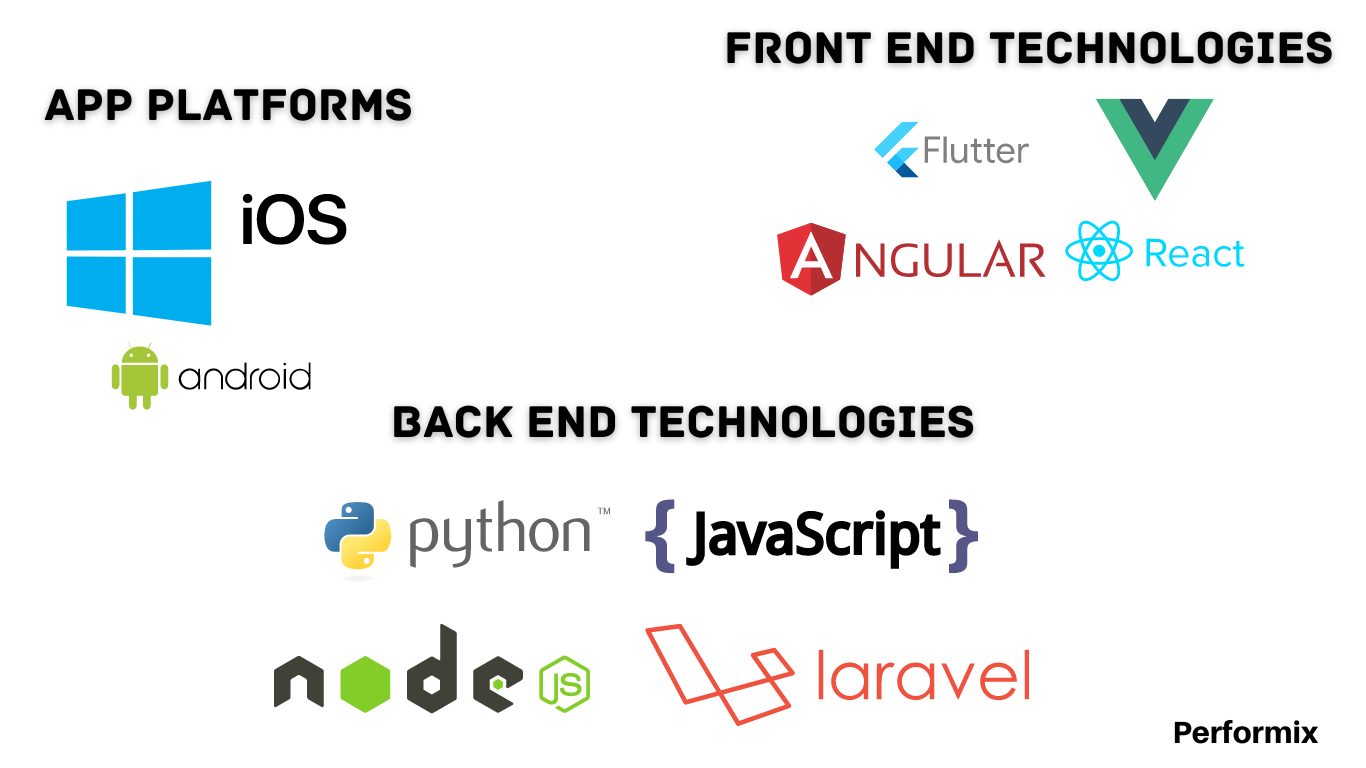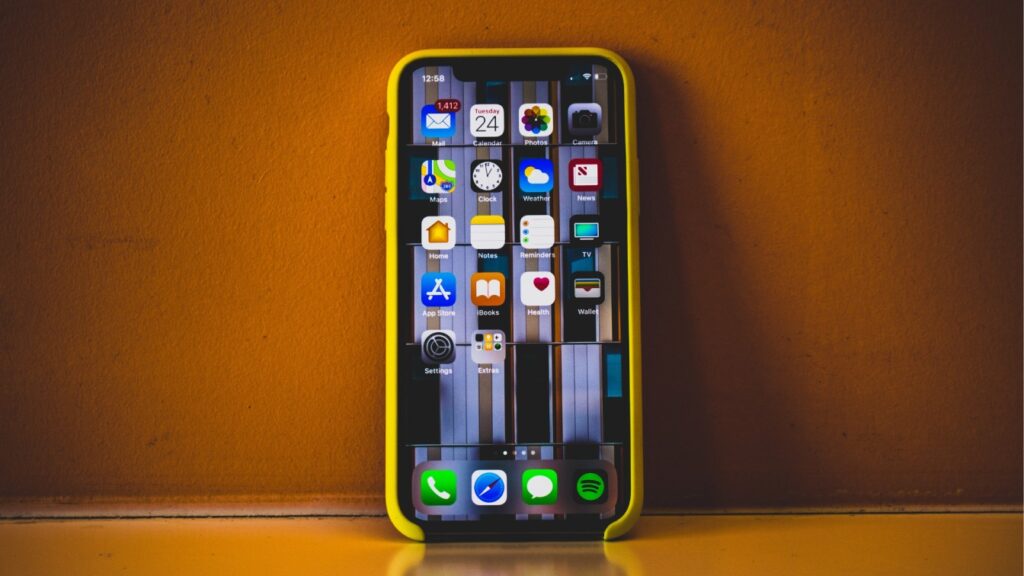Everything you need to know about mobile app development.
A mobile app allows your brand to connect with customers wherever they may be. With more than 2 billion global smartphone users, creating a mobile app is an excellent opportunity for brands to extend their services and reach new audiences. Mobile technology has grown by leaps and bounds over the past few years, so you can now develop faster, sleeker, and more technologically advanced apps. Whether creating a new app from scratch or updating an existing one, producing a user-friendly, fast, and functional mobile app will give your brand an advantage in today’s digital world.
When designing an app, numerous crucial elements must be considered: your mission and goals, your target audience, the app’s features, the functioning, the design, and the user experience. Apart from the basic functionalities and content, mobile apps can perform services, access information, make purchases, or interact with a brand’s followers on social media.
Why you should invest in a custom mobile app?
Here are some reasons you should give serious thought to if you’re still thinking about whether you should create a versatile mobile application for your company.
1. Mobile devices are the future of computing:
These days, more people are accessing the internet through a mobile device than through a desktop or laptop computer, which means that having an optimized app for your audience’s devices is integral to reaching new clients and expanding your brand.
2. Mobile apps are a great way to expand your services:
If you want to provide a service but don’t have the resources or workforce, creating a mobile app is an excellent way to extend those services to a new demographic.
3. More people are using smartphones to shop:
According to a survey by Shopify, more than one-third of all online sales happen on a mobile device. That’s why having an app that allows your customers to shop from their smartphone is essential for keeping up with the modern consumer.
4. Mobile apps are great for customer engagement:
If you want to connect with your customers, having a mobile app is an excellent way to do so. Most apps have some form of social or messaging feature that allows users to communicate with each other and the brand.
5. Mobile apps improve your SEO and ranking:
Your brand can grow in importance on search engines such as Google, Bing, and Yahoo by creating a mobile app, which is a terrific method to boost your SEO.
How to start?
Now that you know the significance of mobile apps let’s examine the framework for creating them.

1.Fix the idea
With daily upgrades and new app releases, the market for mobile apps is thriving. Creating an app that offers value and stands out from competitors is difficult in such a scenario. In balancing usability and design, you must also consider performance, security, and battery life.
To succeed, a mobile app must work fast, be lightweight, and appeal to users in today’s market. This will not be easy for developers, but several guidelines can help. If you don’t know where to begin, here are the top three frameworks to consider before developing an app. Make sure your app is first created for the appropriate platform. Second, concentrate on making it quick and light. Third, think about attracting consumers’ attention with appealing images.
Finally, apply security updates and keep your program current to prevent problems. Creating an application might be difficult, as you can see, but it isn’t something a little imagination and invention can’t handle. Consider these suggestions when you create your mobile solution. When the proper procedures and tools are in place, you can concentrate on developing a solution that will differentiate itself from the competitors.
Fast and light apps are important for mobile devices, know why.
Fast app switching is a boon when you’re pressed for time. You may instantly access the programs you require without waiting for the system to load them one at a time. This is primarily true when several apps are operating in the background. Fast app switching can significantly improve your device’s performance in such circumstances.
Slow app switching can be annoying, especially when an app is loading. In contrast, fast app switching enables you to access your apps without sacrificing quality. Therefore, ensuring that your app functions properly in all scenarios is vital to preventing users from switching between apps.
App developers can make their apps faster by adding speed enhancements like multithreading or limiting the number of open tabs in the browser. No matter how many apps are running in the background, doing this makes that rapid app switching function without a hitch.
2. Recognize Your Market: User Research and Targeting
It would be best if you do research to understand your target market before diving headfirst into designing and developing your app. User research is a crucial component of app development since it will help you better understand your consumers and adjust the features and functioning of your app to suit their requirements. You may perform user research for your app in a few different ways.
Surveys
Although surveys can be pretty versatile, you cannot discuss real-world circumstances or ask follow-up questions. They are excellent for creating broad viewpoints but less for identifying needs and problems.
Focus groups
A focus group is a terrific way to delve deeper into consumer behavior. Focus groups are a more thorough research strategy since they let you ask follow-up questions and talk about actual situations.
One-on-one interviews
These interviews go deeper than focus groups but aren’t as scalable. Even though one interview won’t represent your entire target group, it will still give you a ton of insight.
Personal observations
Personal observations are excellent for businesses looking to acquire a close-up view of their clients and how they interact with the outside world. However, it’s not always practicable or easy to undertake in-person observations.
Do you know that we engage with mobile apps 90% of the time and spend 2 hours each day using them on average?
The $693 billion in revenue generated by mobile apps in 2021 is predicted to rise to $935 billion by 2023, states a report by Statista.

3. Create a Wireframe for Your App
Once your list of ideas is complete, it’s time to use wireframes to give your thoughts form. A wireframe is the shape of the design plan for your application. It will show off your app’s functionality and design and will aid in your comprehension of how the application functions and looks.
App wireframes provide the team with an articulated theory to follow by serving as a guideline or reference for developers.
- Configure a Mobile Frame
Choosing a frame that matches the specifications of the device you are designing is preferable. As a natural limitation, the structure should prevent you from packing too many things onto a single screen. Second, a frame should create the appearance of the actual frame design.
The best advice is to start with a device with a mid-screen size. For instance, use the iPhone XS framework for developing an iOS business app.
- Employ design patterns
The main priority in UX design is familiarity. Users can draw on previous interactions with a new product when they notice recognizable User Interface components in it. Native design patterns for iOS and Android might make it easier for designers to create a recognizable user experience. Design patterns can serve as reusable building blocks that can address frequent problems.
- Verify the Scalability of Your Content
Will the iPhone XS display your screen’s design well? I love that! Nevertheless, they will all appear fantastic on whatever size screen. Even if your screen design seems excellent on the phone with a medium-sized screen, like the iPhone XS, that doesn’t guarantee that owners of the iPhone 5 and iPhone XS Max will have the same experience. When wireframing, median screen size is acceptable, but it’s also crucial to verify how your content appears on each size and make the appropriate adjustments.
Taking the wireframing to the next level, go for a design sprint.
You will doubt whether the design decisions you are making during wireframing are sound or not. Perhaps one layout is superior to another, or a new function has to be included. A Design Sprint is an established, scientific method of group brainstorming that aids in determining which features to construct first and which ones to drop. Showing ideas and laying the foundation for wireframing and designing helps cut down on development time and costs.
The Value Of A Design Sprint
- Developing a new good or service
- Redesigning the current item or service
- Adding features to an existing interest or service
Why wait? Get your user-tested product design sprint just in 5 days.
Visit Performix Product Design Sprint
4. Choosing the right platform and technologies
Platform Selection:
Your budget and target audience are the two main factors to consider when deciding on which operating system you want to build your app. Each operating system has advantages and disadvantages that you should consider before choosing.
iOS:
Creating for iOS is a fantastic choice if you’re searching for a platform with broad appeal. Over 1 billion people use Apple’s iOS, making it the world’s second most widely used operating system. However, developing for iOS is infamously more expensive than doing so for other platforms.
Android:
With over 2 billion users, Android is the world’s most widely used operating system. It is the most popular platform for creating mobile apps because of this. Investing your time and money in Android development is an excellent choice if you want to reach a large audience.
Windows:
You might want to consider creating for Windows if iOS and Android aren’t the best platforms for reaching your target market. Despite having a smaller market share than Android, Windows has a greater conversion rate and less expensive development.
iOS and Android are your best options to reach as many people as possible. You can think about developing for BlackBerry, Symbian, or Windows Phone if you concentrate on a particular market, such as commercial or enterprise users.

Frameworks Selection:
An ideal front end must be quick, light, visually appealing, and straightforward. For consumers to access it consistently across platforms, including desktop and mobile web browsers, as well as mobile apps, it should function smoothly on all devices. In contrast, the portion of an application that handles all the processing and heavy lifting is called the “back end.” This comprises activities like data handling, data storage, and data validation, among others.
Listed below are the potential trending frameworks for developing mobile applications adaptable to Android and iOS.
React Native
One of the top frameworks for developing mobile apps is React Native. React Native is an open-source, cross-platform application development framework created and backed by Facebook. Developing mobile applications for iOS and Android is made easier with React Native. It makes it simple to employ a single codebase across all platforms by enabling the creation of platform-specific versions of numerous functionalities. Tesla, Airbnb, Skype, and Amazon Prime are the best examples.
React Native’s primary benefit is that it makes development and implementation more efficient. React Native has other crucial features, including component-based GUI design for front-end apps, integration with third-party extensions, and reusable elements.
Flutter
With a straightforward codebase, you can build native Android and iOS applications using Google’s Flutter framework, which is open source and free. It is one of the best and most reliable smartphone UI frameworks for hurriedly creating engaging apps by expediting development. Flutter is a comprehensive and accurate framework that offers tools to help developers create and launch appealing mobile applications, widgets, a rendering engine, debugging, and integration APIs. Many well-known companies, including Google and Abbey Road Studios, have embraced Flutter.
Angular Js
AngularJs is a JavaScript open-source front-end framework (SPAs). It is mainly used to create single-page web apps. Because TypeScript is used to build Angular, developers can quickly find flaws, maintain clear, intelligible code, and correct mistakes. RxJS may be used to handle asynchronous data calls with ease. Organizations using Angular-based applications are Xbox, Forbes, BMW, and Blender.
JavaScript
Using JavaScript app frameworks, you can create cross-platform, iOS, Android, and even cross-platform apps. JavaScript has the ability to validate, manipulate, and calculate data in addition to editing and modifying CSS and HTML. The app’s improved UI/UX is made possible using JavaScript, including current scrolling video jukeboxes, recent content changes, animated 2D/3D visuals, interactive maps, Etc. A few well-known examples include Uber, Netflix, LinkedIn, and Paypal.
Vue Js
Vue is a clear-cut, easy-to-use framework that supports users with various tasks and can easily handle dynamic and straightforward procedures.
Despite fewer Silicon Valley adopters, Vue’s adoption rate keeps increasing. Although the framework was created to improve app performance and deal with complexity, market titans do not generally find it very well-liked. However, this architecture is utilized by Xiaomi, Alibaba, and Reuters.
Express
For backend/server-side development, Express is a Node.js framework. Web applications that are single-page, multi-page, or hybrid can be created using it. In several well-liked development stacks, such as the MERN, MEAN, or MEVN stacks, Express.js serves as the backend component alongside a JavaScript frontend library or framework. You can manage a variety of different HTTP requests with its assistance.
Laravel
Laravel is a reliable PHP web application framework. Utilizing components from many frameworks to build a web application is its best feature.
Neighborhood Lender, MyRank, Laracasts, Deltanet Travel, Creative Spaces, Watchseries, and Creative Spaces are the most well-liked applications.
Python (Frontend and Backend)
Python is an elementary programming language that combines dynamic typing and binding. Python enables you to create mobile eCommerce apps compatible with various operating systems, including Android and iOS. Additionally, it features cross-platform support, allowing your code to run on several strategies without needing any complicated additions. Python’s support for test-driven development is a tool used by programmers to create mobile application prototypes. The top Python-using apps include Instagram, Pinterest, Spotify, Dropbox, Uber, and Reddit.
In a nutshell, these technologies form the foundation of your app. Maintaining smooth operations at both ends of the equation is the main challenge in developing a fast, lightweight app because the front end is powerless until the back end’s data processing is completed.
5. Making a Working Prototype
It’s time to start constructing as soon as you clearly understand your users! While designing and developing your app, you should consider a few key features.
Functionality
Check that your app has all the features and functionality listed in the description—including any in-app purchases, social media functions, and other services accessible through your website.
Speed
The technical part of things starts here. Make sure your app is as quick as it possibly can be. You’ll lose around 60% of your users if it takes your app longer than three seconds to load.
User Experience Design
As was previously said, any software must have an outstanding design. But having a beautiful app isn’t enough; your app’s user experience is also crucial.
6. Incorporate Animation and Visual Components
What distinguishes your software from the competition are the visual components and animation. The images or graphics that appear within the app are referred to as visual elements. The movement or alteration of the pictures is called animation. You should incorporate a few critical components into your app to make it stand out from the competition.
Branding
Your app should represent your company’s identity. Make sure the imagery in your app adheres to the branding of your website if you intend for it to contain any.
Navigating components
Your navigation system should be simple to use and intuitive. Your users should be able to locate what they’re seeking and finish their jobs without encountering problems or becoming upset.
Interface with social media
To enable users to share their experiences with their friends and followers on social media, if your app has a social component, ensure it has all of the required social media integrations.
7. Testing
Please make sure your app functions correctly before making it live. Mobile application testing is a procedure used to examine the consistency, usability, and functioning of application software created for portable mobile devices. Apps optimized for popular mobile-OS configurations among their target market allow smooth user experiences across all platforms and devices.
Testing Stages For Mobile Apps
Documentation testing:
The approach to developing mobile apps begins with screen layouts, navigational diagrams, and other crucial elements that are difficult to see in the design. Before the app’s construction begins, this step allows all developers to identify and correct any differences. At this point, you must verify the completeness and consistency of all the desired characteristics.

Functional analysis:
It helps you test your mobile app replies per market standards. Keep the following elements in mind while you conduct functional testing for your mobile app.
- Business functionality: It can be used for online banking, social media, education, ticketing, the gaming sector, and more.
- The target market includes business owners, organizations, students, Etc.
- The Distribution channels: Google Play, the App Store, direct delivery, Etc.
Usability evaluation:
This round of testing verifies that your software provides a user-friendly interface that complies with industry standards and enables comfortable browsing for all of your clients. It offers quick and simple mobile apps that might draw users.
User interface testing
verifies that the graphical user interface of your program complies with all requirements.
Determining compatibility:
Testing for compatibility and configuration ensures that your mobile app operates as efficiently as possible, given the device’s hardware, screen resolution, operating system, and other factors.
Performance evaluation:
Performance testing can assist you in evaluating the responsiveness and consistency of your mobile application under a particular demand. We will now demonstrate numerous performance testing types, including:
- A load test
- Stress Examining
- Stability Evaluation
- Length Testing
- Parallel testing
Security examinations:
This testing procedure verifies your application’s security concern. Additionally, it assesses the dangers of malware, infections, security, and illegal access to all critical data.
Certification testing:
The certification testing process examines if your software complies with industry standards, license agreements, terms of use, and all specifications of stores like Google Play, App Store, and Windows Phone.
8. Deploy Your App’s Beta Version Online
Any application’s beta version has the potential to draw early adopters, which is a crucial step in making your mobile app popular. Early adopters offer a wealth of insightful commentary on the advantages and disadvantages of your application. Additionally, their ratings and experiences can help you comprehend how well-liked and in-demand the software is. This kind of word-of-mouth advertising will improve your mobile app’s reputation and assist the administrator in gaining more users.
9. Launch your App
You created, tested, and created your application’s structure. It is now time to debut it in the Apple Store or Google Play Store.
10. Action Following Launch
The following and most important stage after releasing your mobile app is marketing it. Users are unlikely to install your software if they are unaware of it. Consider creating engaging and educational films that can demonstrate the functionality of your app to promote awareness of it and encourage users to explore it. Don’t overlook the power of social media, and use all available digital channels to connect with people everywhere. It will give customers a sneak peek at your app and highlight the salient elements that can make life easier.
Bravo! How laborious a process is it to create and introduce a mobile application? But now that you have the answer, you may unwind. From designing and developing to launching a mobile app for your brand, we’ve covered you from A to Z.
Set up a discovery call now!
Performix has a firm grasp on all types of apps, including those used in business, government, finance, education, e-commerce, and more.
Ensure you are developing the best-customized apps to combat digital transformation, maintain consistency, attract customers and stand out with your brand.







